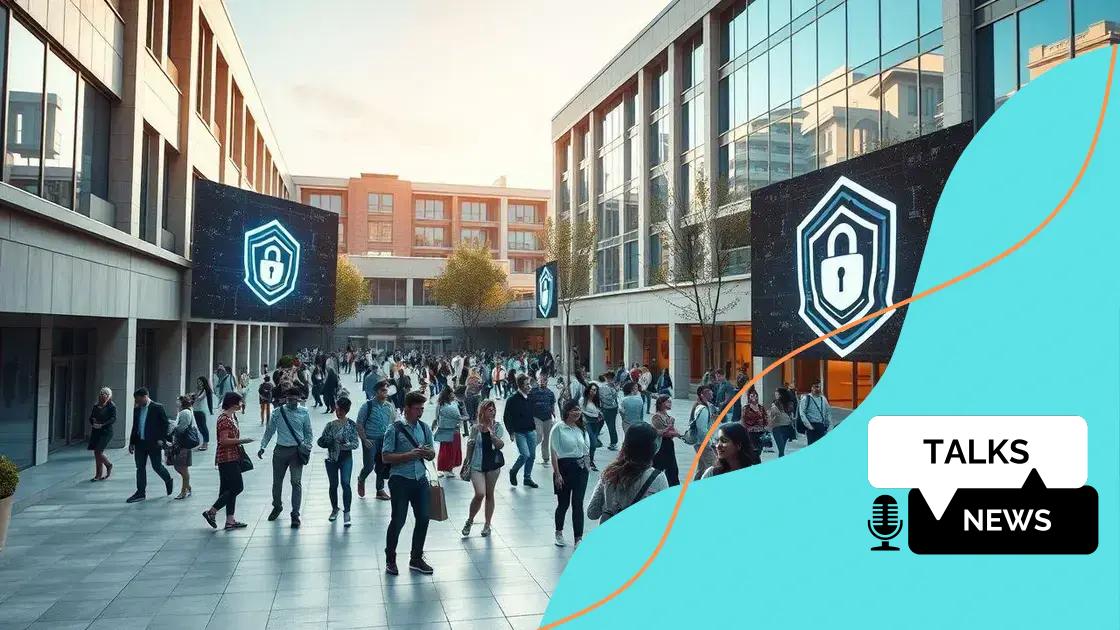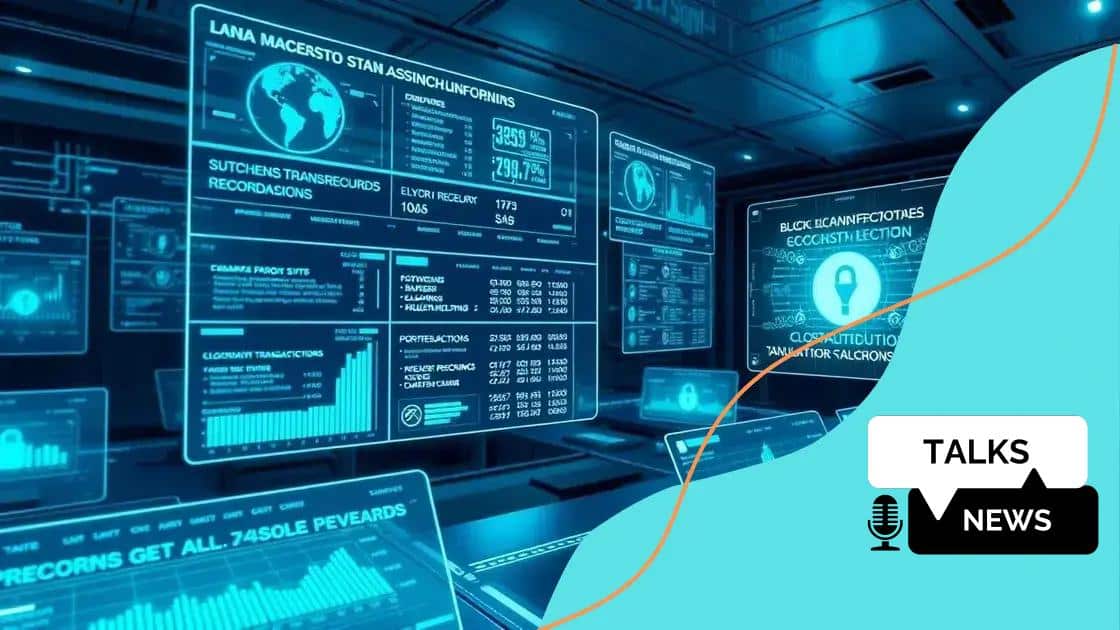Blockchain technology for secure academic credentials

Blockchain technology for secure academic credentials enhances verification processes by providing transparent, tamper-proof records that simplify credential verification and improve trust in educational achievements.
Blockchain technology for secure academic credentials is transforming how we validate educational achievements. Imagine a world where your diploma cannot be faked! Let’s dive into this innovative approach and its implications.
Understanding blockchain technology
Understanding blockchain technology is crucial in our digital age. This technology is often seen as complex, but it serves a simple purpose: enhancing security and transparency in various transactions.
At its core, blockchain is a decentralized ledger that records transactions across multiple computers. This means that no single entity has control over the entire database, making it incredibly hard to alter or hack. Let’s delve deeper into how this works.
Key Features of Blockchain
There are several defining characteristics of blockchain technology:
- Decentralization: Unlike traditional databases, blockchain data is spread across a network, reducing the risk of central points of failure.
- Transparency: Each transaction is visible to all participants, fostering trust and accountability.
- Immutability: Once a transaction is recorded, it cannot be changed or deleted, ensuring integrity.
- Security: Advanced cryptographic techniques safeguard data, protecting it from unauthorized access.
These features contribute to the growing adoption of blockchain technology in various sectors. Industries such as finance, healthcare, and education are leveraging this technology to verify and secure records, making them more reliable.
Realistically, understanding blockchain also means considering its implications. For instance, using blockchain for secure academic credentials can mitigate fraud in degree verification, allowing institutions and employers to trust the legitimacy of records.
How Blockchain Works
At its heart, blockchain operates through a process called mining. This involves participants, known as miners, solving complex mathematical problems to validate transactions. Once verified, these transactions are grouped and added to a new block.
This block is then linked to the previous one, forming a chain. This chain of blocks is where the term “blockchain” originates. This connectivity ensures that all information is consistently updated across the network, enhancing the security of the entire system.
In conclusion, blockchain technology stands as a revolutionary tool that is reshaping how we secure and validate transactions. Its ability to provide transparency, security, and decentralization makes it a vital technology for the future.
Benefits of blockchain for academic credentials
Benefits of blockchain for academic credentials are significant in today’s education landscape. This powerful technology helps to create a more transparent and trustworthy system for verifying academic achievements.
One key benefit is the prevention of fraud. Traditional paper degrees can be easily faked; however, with blockchain, academic records are securely stored and can be verified by anyone. This helps institutions maintain their credibility.
Key Advantages of Blockchain
Here are some major benefits of using blockchain for academic credentials:
- Enhanced Security: Blockchain uses advanced cryptography, making it nearly impossible for unauthorized individuals to alter records.
- Instant Verification: By using blockchain, employers and schools can verify qualifications instantly, reducing wait times and administrative burdens.
- Decentralized Record Keeping: No single authority controls the records, which diminishes the risk of data loss or manipulation.
- Cost Efficiency: Reducing paperwork and manual checks leads to lower costs for institutions.
Implementing blockchain creates a more efficient process for managing academic records. For example, a student can easily share their verified credentials with potential employers or educational institutions, ensuring authenticity without the hassle of contacting previous schools.
Furthermore, this technology promotes lifelong learning. As people pursue various educational paths, maintaining a digital portfolio of credentials becomes seamless. This access to verified achievements encourages continuous professional development.
Improving Trust in Education
The use of blockchain helps to build trust in the education system. When academic credentials are stored securely and are easily verifiable, employers gain confidence in hiring candidates based on their achievements. Additionally, this can help institutions attract students who seek quality education, knowing their degrees will hold value in the job market.
Overall, the adoption of blockchain technology for academic credentials enhances the quality, security, and accessibility of educational records. As more institutions implement these systems, the future of education looks promising.
How blockchain enhances verification processes

How blockchain enhances verification processes is an essential topic in the realm of technology and education. This innovative technology allows for more reliable and quicker ways to confirm academic credentials.
First, blockchain provides a decentralized system for storing records. This means that no single entity has control over the information, reducing the risk of tampering. Each transaction or record is securely linked to previous entries, creating an unbreakable chain of data.
Key Enhancements in Verification
There are several ways in which blockchain improves the verification process:
- Real-time Access: Institutions can access verified credentials instantly, speeding up the hiring or admissions process.
- Improved Accuracy: By eliminating manual entry and paperwork, the chances of human error are greatly reduced.
- Fraud Prevention: Tampering with blockchain records is almost impossible, making it difficult for individuals to present fake qualifications.
- Streamlined Sharing: Students can easily share their credentials with employers or other educational institutions without extensive bureaucratic procedures.
The enhancement of verification processes through blockchain leads to increased trust. Employers can directly verify the authenticity of a candidate’s credentials without making phone calls. This quick access to information allows for more informed hiring decisions.
Moreover, as educational institutions adopt blockchain technology, they contribute to a culture of transparency. This not only helps students demonstrate their qualifications but also holds institutions accountable for the validity of the degrees they issue.
Future Implications
As more sectors begin to understand the benefits of blockchain, we will likely see wider adoption in various fields, from finance to healthcare. Each industry will benefit by improving the verification process, ensuring that individuals truly possess the skills and qualifications they claim.
In summary, leveraging blockchain technology in verification processes signifies a progressive step towards enhancing trust and efficiency in academic and professional settings.
Challenges in implementing blockchain in education
Challenges in implementing blockchain in education are important to understand as institutions consider adopting this technology. While blockchain offers numerous benefits, there are hurdles that must be addressed before widespread usage can occur.
One major challenge is the lack of understanding among educators and administrators. Many people are still unfamiliar with what blockchain is and how it works. This can lead to resistance to change and slow down the adoption process.
Key Challenges Faced
Here are some common obstacles that institutions encounter:
- Technical Integration: Existing systems may not easily integrate with blockchain technology. This can require significant investments in new infrastructure.
- Data Privacy Concerns: Institutions must ensure that student information is protected. Some may worry that a public blockchain could expose sensitive data.
- Regulatory Compliance: Education systems vary by country, and institutions need to navigate different regulations regarding data storage and sharing.
- Cost of Implementation: The initial investment needed for blockchain solutions can be substantial, which may be a barrier for some institutions.
Despite these challenges, it is essential to consider the potential long-term benefits. For example, once blockchain is integrated effectively, it can lead to cost savings over time. Institutions can streamline processes and reduce the administrative burdens associated with managing academic records.
Moreover, as the technology evolves, many of these challenges may diminish. Educators and technology developers must work collaboratively to create solutions that address privacy issues while maintaining the integrity and security of academic records.
Future Considerations
As more schools pilot blockchain programs, it will be crucial to share insights and lessons learned. This collaborative effort can help ease the transition and overcome resistance to adopting new technologies. By addressing these challenges openly, institutions can better prepare for a future where blockchain technology is an integral part of education.
Future of blockchain in academic credentialing
The future of blockchain in academic credentialing holds immense potential. As technology advances, more educational institutions are considering how to leverage blockchain for secure and efficient record-keeping.
One exciting possibility is the creation of a standard for verifying degrees and qualifications across different platforms. This would allow students to carry a digital wallet containing all their verified credentials. Whenever they need to provide proof of education, they can simply share their digital wallet.
Key Trends to Watch
Several trends are shaping the future of blockchain in education:
- Increased Adoption: More colleges and universities are adopting blockchain solutions to manage academic records, making verification simpler and faster.
- Collaboration Between Institutions: Schools may work together on shared blockchain platforms, creating a unified approach to credentialing.
- Integration with Other Technologies: Combining blockchain with other technologies like artificial intelligence can enhance the verification process and data analysis.
- Global Standardization: There is a possibility for global standards in blockchain-based credentialing, allowing employers and institutions worldwide to recognize qualifications easily.
These trends show that there is a strong shift towards accepting blockchain as a reliable method for handling academic credentials. This could lead to a significant reduction in fraudulent claims of education and build trust in the hiring process.
Furthermore, as more individuals seek flexible learning paths, blockchain will enable the recognition of non-traditional education. Micro-credentials and online courses can be easily verified, allowing learners to showcase their skills effectively.
Long-Term Implications
In the long run, the widespread use of blockchain in academic credentialing will promote a culture of trust and transparency. Students and employers will benefit from a more straightforward process that eliminates bureaucracy. As we continue to explore the boundaries of technology, blockchain could very well redefine how we perceive and validate education.
In conclusion, the integration of blockchain technology in academic credentialing stands to revolutionize how we validate education. From improving security and transparency to enabling lifelong learning, the benefits are clear. Although challenges exist, the potential for a more efficient and trustworthy system is exciting. As educational institutions embrace these changes, students and employers alike will experience significant advantages in the credibility of academic records. With ongoing advancements, blockchain could reshape the future of education.
FAQ – Frequently Asked Questions About Blockchain in Academic Credentialing
What is blockchain technology?
Blockchain technology is a decentralized digital ledger that securely records transactions across multiple computers, ensuring data integrity.
How does blockchain improve security for academic records?
Blockchain enhances security by storing records in a way that makes tampering nearly impossible, providing verifiable credentials.
What are the benefits of using blockchain for academic credentialing?
Using blockchain for academic credentialing ensures transparency, reduces fraud, simplifies verification processes, and can lower administrative costs.
What challenges do educational institutions face when implementing blockchain?
Institutions may face challenges such as a lack of understanding, data privacy concerns, costs of implementation, and technical integration with existing systems.





